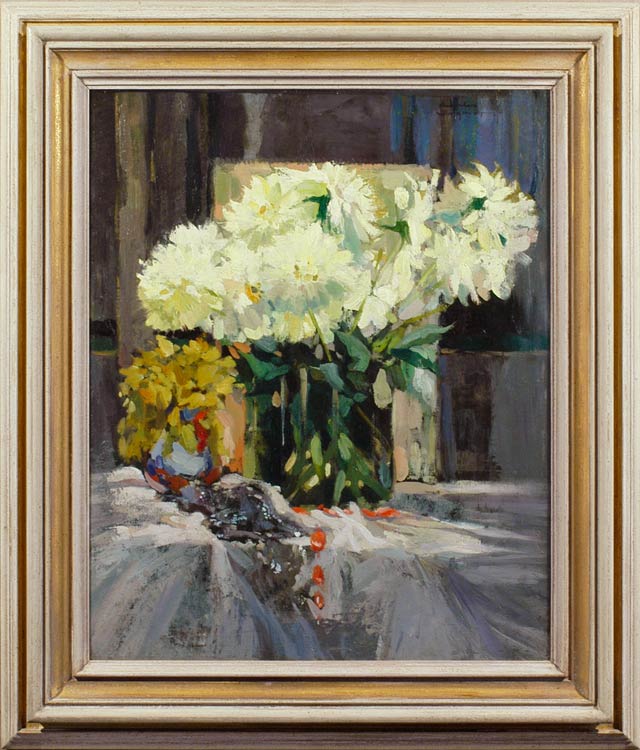This is an example of Swyncop’s broad, painterly style at its best, his brushwork catching the shape of petals, leaves and folds of cloth in rapid, graphic strokes. His painting technique is in completely opposite style to the careful delineation of scenes and buildings in his etchings. He specialized in flowerpieces, landscapes and figures – especially of children – producing tranquil, colourful compositions of the first and last which seem to exist in a happy Eden, untouched by the darkness in his urban scenes. This present flowerpiece is beautifully balanced and composed against its shadowy ground; the coloured tones on the white petals and the highlighted glass vase are both sensuous and accurately observed.
Biographical details
Charles Swyncop was a Belgian painter, designer and print maker, born in Brussels in 1895. He studied first under his elder brother, Philippe (who was 17 years older than Charles), and who was an engraver, a graphic artist decorative painter. Like his brother, Charles then moved to the Brussels Academy of Fine Arts, where his teachers were Jean Delville, Herman Richer and Alfred Bastien, and where he won third place in the Prix de Rome of 1920.
After studying in Rome he joined some of his fellow students in Brussell to work, under their teacher, Bastien, on the vast Panorama of the Battle of Yser. Bastien had worked as a sort of unofficial war artist from 1915, much of his work being published in the British Illustrated War News, some of it in the form of large semi-panoramic double-page spreads. After the war, he translated his sketches and photos into the Panorama de l’Yser, which measured 115 metres by 14 metres. It was exhibited initially in Brussels, where it was seen by more, it is estimated, than 800,000 visitors, and then transferred to a purpose-built gallery in Ostend.; it was badly damaged in a bombing raid in 1940. The group of ex-students and Bastien’s war-time colleagues, incuding Charles Swyncop, who worked on the project, took a year to complete it.
Later in the 1920s Swyncop travelled to Italy again, Venice and Spain, where his brother lived for twelve years, and where he produced work in various genres – portraits, figure paintings, still life, landscapes and marines.
Again with Alfred Bastien, and other artists such as Jules Brouwers, Swycop joined the group La Lierre, exhibiting with them at the Toison d’Or in Brussels. He also took part, with his brother, in a group exhibition at the Maison d’Art Moderne in Brussels in 1920. In 1930 he was commissioned by the Belgian State to paint decorative panels for a pavilion at the Exposition Universelle of 1930 in Antwerp. He exhibited at various salons, including the 1933 and 1937 Salons at Ghent. In 1938 he became a teacher at the Academy of Fine Art in Ixelles, where he remained until his death in 1970; his pupils include Isi Koslowitz, Charles Delaite and Doris Kiesewetter. In 1963 he illustrated the cover of the cataslogue for the exhibition, 100 years of Art in Ixelles.
For further reading on flowerpieces please click here


